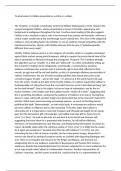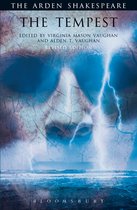To what extent is Caliban presented as a victim or a villain.
The Tempest, a romantic comedy play written by William Shakespeare in 1611, features the
unusual antagonist Caliban, whose presentation in terms of morality, appearance and
background is ambiguous throughout the text. A surface-level reading of the play suggests
Caliban to be a mystical creature, who is far removed from society and humanity, whereas a
critical reader would look at the text through a post-colonial lens. This view of the allegorical
Caliban is a key deciding factor into whether or not an audience should sympathise with the
indentured character. Literary critic Welles observes that the play is “kaleidoscopically
different from every angle”.
Initially, Caliban (whose name is a near anagram of cannibal, which is a negative stereotype
against black natives among early Europeans, aiding to support the post-colonial view of the
play) is presented as villainous through the protagonist, Prospero. This is evident through
the adjectives such as “brutish” [1.2 356] and “abhorred” [1.2 350], immediately setting up
the character of Caliban to be antagonistic. Contextually, a contemporary Jacobean
audience would perceive a person who is outwardly ugly to have that reflected in their
morals; an ugly man will be evil and devilish, so this is a seemingly villainous presentation of
Caliban. Furthermore, the use of harsh sounding syllables that almost pierce the script
connotes imagery of spite – and on the stage – it’s almost as if the words have to be spat
from the actors' mouth at the sight of the horrific Caliban. It could be argued that Caliban is
fundamentally evil, being born from the cruel witch Sycorax, as he is described as being “got
by the devil himself”. Due to his origins, he has no hope of redemption, and he has no
human emotion. Critic Dryden says that Caliban has the ”malice of a witch”, suggesting that
this is something hereditary, cautioning the audience of Caliban’s true nature. During King
James I’s reign, witchcraft and dark magic were demonised due to the monarch's hatred for
witches. Witch hunts were becoming increasingly popular, so much so that King James I
published the book ‘Daemonologie’, an anti-witch book. A contemporary audience would
perceive Caliban as villainous due to this reasoning. To further argue that Caliban is
inherently evil, it is important to note that Prospero and Miranda had taught to him speak,
gave him the benevolent gift of knowledge, and Caliban took that gift to “know how to
curse” [1.2 364] – he took an altruistic act and bent it to his horrid and demonic will,
suggesting that even when he is presented with kindness, he will still be villainous.
Moreover, he had attempted to rape Miranda, and despite being intercepted, he shows no
regret. He boldly states (after the nefarious cackle of “O ho, O ho” [1.2 348]) that he would
do it again and would have “peopled else//this isle with Caliban's” [1.2 349], not only
insinuating he has a lack of human empathy, but he is also power hungry, desperate to
overrun the island (or perhaps European society as a whole) with disgusting ideologies and
acts. There is no empathy and remorse for the illegal, sacrilegious, and immoral act,
antagonising him to any audience, especially to Renaissance and Twenty-First Century
audiences. Despite the unlawful behaviour he has been subjected to, to many audiences the
act of rape would make Caliban an irredeemable character. Another interpretation of
Caliban’s character, and this scene in particular, could be that he is a representation of





